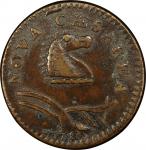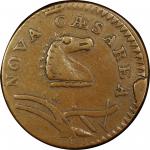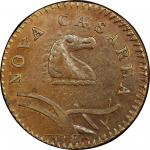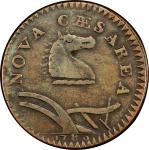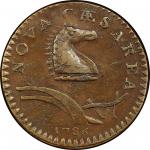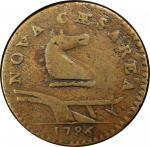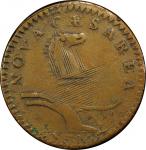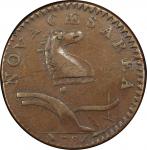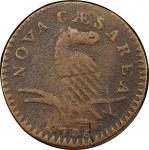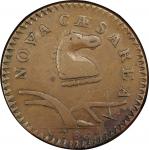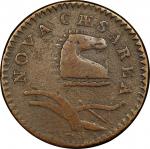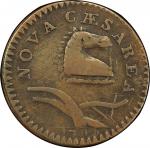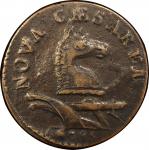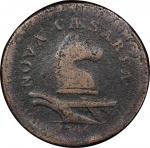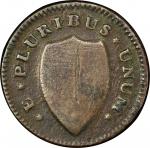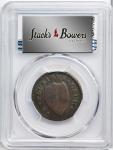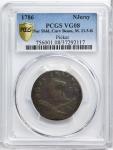1786 New Jersey copper. Maris 21 1/2-R. Rarity-8. Narrow Shield, Curved Plow Beam. VG-8 (PCGS).152.3 grains. A great rarity in the New Jersey series, a variety that has been offered at auction just three times in history, once for each known specimen. This example, the second discovered, last sold publicly in 1984. It was described at the time as: “Well centered with all the reverse denticles. Smooth even wear with all details visible, the 1 in the date weak. Uniform, chocolate brown, matte-like surfaces. A couple of pin scratches on the reverse shield. Of utmost importance. Very Good.” The surfaces are still pleasing deep steel and olive, finely granular but not unattractive, with decent gloss and eye appeal. There is some old verdigris around peripheral design elements, especially the lettering of the reverse legend. A vertical scratch on the shield is the most notable flaw, though there are some shallower scrapes on the shield seen, an old dent on the base of the horsehead device, and a light bruise under the date. The distinctively shaped slender horsehead and the sharply angled plow beam, reminiscent of those on the No Coulter dies, are all easily seen here.<p>Siboni, Howes, and Ish advance a theory that this obverse and Maris obverse 23-1/2 are transitional dies between the No Coulter obverses and the With Coulter obverses that came later in the series. While there is much to recommend this concept, the contention that these dies may have started as No Coulter dies is unnecessary to advance the theory, unsupported by the (lack of) evidence, and unlikely from what we know about die production. The Maris 21-1/2 and 23- 1/2 obverse share many design elements with the No Coulter obverses: slender horseheads, long plow bars that meet the handles at a nearly right angle, tiny date numerals, and shaggy manes. The stylistic similarities certainly suggest that they could have been — and likely were — crafted by the same anonymous engraver. The die rotations of these two varieties are also similar to those found in the No Coulter varieties, most of which are typically found in medal turn or some slight variation thereof. (Interestingly, the Maris 22-P, a No Coulter variety, is found struck in coin turn, as is Maris 10-h, Maris 10-gg, 11-hh, and 11-1/2-G.) If we had to guess, the dies were probably created at an adjacent period of time, and the coins were probably struck at a similar time also. The idea that a fragile and valuable steel die would be amended to make sure the plow was perfectly rendered in technological conformity, however, is baseless. The general sense of the theory remains, and we’re happy to accept its likelihood.<p>The die rotation on this specimen is perhaps 30 degrees counterclockwise from standard medal turn, a distinctive rotation. The Ford specimen was essentially perfect medal turn. This information is far more vital to the understanding of these varieties than the length of their coulters.<p>The Ford coin, easily the finest known despite its rim flaws, was the discovery piece, identified by Hillyer Ryder just after the turn of the 20th century. One hundred years after Ryder acquired it, Bill Anton paid $51,750 for it in the first Ford sale. This piece was cherrypicked by Richard Picker, probably in the late 1950s or 1960s — late enough that Breen didn’t know about it when he was annotating the Wayte Raymond boards that housed the Boyd-Ford New Jerseys. Picker would have known the variety from its first publication: the 1914 American Numismatic Society Exhibition catalog, where Ryder’s coin was described as “Obverse not in Maris.” It took until the eBay era for a third example to turn up, described as “F-“ in the SHI Census. This one, called G, is considered the bottom rank of the three. Despite this placement, it remains a top shelf rarity in the New Jersey series.From the E Pluribus Unum Collection of New Jersey Coppers. Earlier, from Stack’s sale of the Richard Picker Collection, October 1984, lot 199; William Anton Collection; E Pluribus Unum Collection, via Larry Stack.


